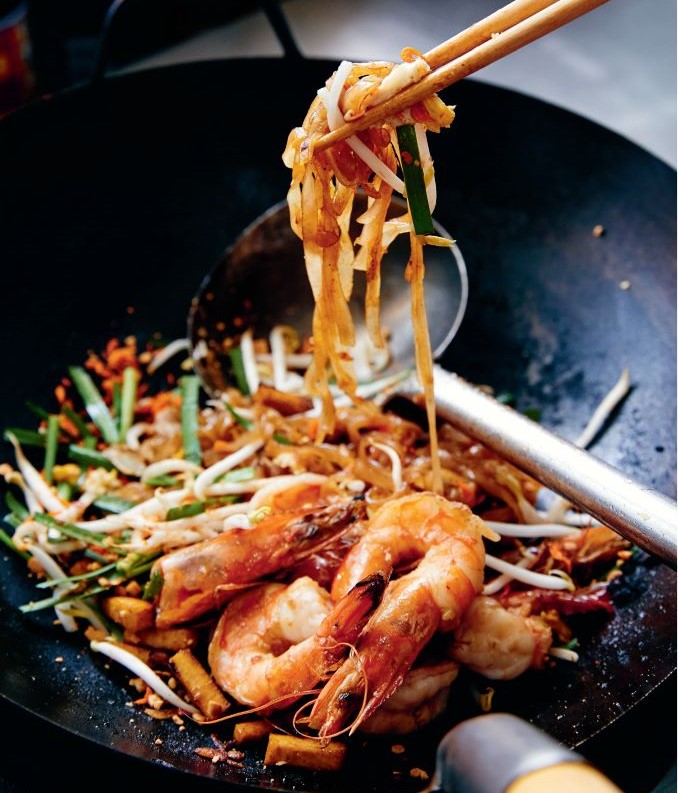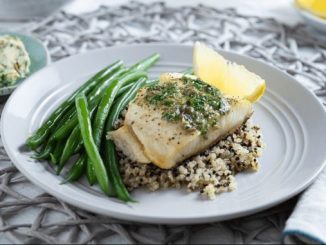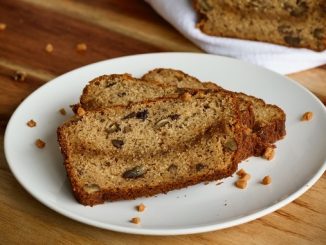Chef Nuit shared her recipe for her bestselling dish at PAI: Pad Thai. This recipe can be found in her award-winning cookbook, Kiin.

Stir-Fried Rice Noodles in Tamarind and Palm Sugar Sauce | Pad Thai
Serves 1
When I started cooking in Canada, so many people asked me to put ketchup in my pad Thai, but I never would. So many people are surprised by the taste of this dish in my restaurants, because they have probably never had it without ketchup.
This is the most popular Thai dish outside of Thailand. A sweet, savoury, and sour stir-fired rice noodle dish traditionally made with a tamarind-based sauce (not ketchup). It can easily be adjusted to meet your spice level. Roasted peanuts and a dash of lime add a nutty and citrusy coating for an incredibly deep flavour.
Remember, stir-fry dishes use a high heat to cook. Make one serving at a time to allow the heat to go all the way through the noodles and give a better flavour.
Note: you’ll need to soak the noodles for about 4 hours.
Ingredients:
Sauce (makes extra)
-1 cup grated palm sugar
-1 cup water
-¾ cup Tamarind Paste (recipe follows) or store-bought
-½ cup Thai oyster sauce
-¼ cup Thai fish sauce
-2 tablespoons sweet soy sauce
Pad Thai
-3½ ounces (100 g) plain dried medium instant rice noodles
-3 tablespoons sunflower oil
-5 fresh or thawed frozen medium shrimp (size 21–25), peeled and deveined
-1 teaspoon minced shallots
-¼ cup firm tofu cut into ½-inch cubes
-1 egg
-1 cup bean sprouts
-¼ cup Chinese chives cut into 1½-inch pieces
-2 tablespoons ground unsalted roasted peanuts
-1 lime wedge
Directions:
1. To make the sauce: In a small saucepan, combine the palm sugar, water, tamarind paste, oyster sauce, fish sauce, and sweet soy sauce. Cook over medium heat, stirring occasionally, for 3 to 5 minutes, until the sugar has fully dissolved. Remove from the heat. (The sauce can be stored in an airtight container in the fridge for up to 1 week or in the freezer for up to 3 months.)
2. Soak the noodles: Place the rice noodles in a large bowl and add enough room-temperature water to cover them by 2 inches. Let soak until soft, about 4 hours. Keep the noodles in water until just before cooking to prevent them from drying out.
3. To make the pad Thai: Heat a large wok or skillet over high heat for 2 minutes. Reduce the heat to medium and then add the sunflower oil. Add the shrimp and cook, stirring occasionally, until the shrimp turn pink but are not yet fully cooked, 1 to 2 minutes. Push the shrimp to the side of the wok. Remove from the heat and add the shallots and tofu and cook, stirring frequently so the shallots cook thoroughly, 1 to 2 minutes. Add 1/3 cup of the sauce and stir to mix. Return the wok or skillet to medium heat.
4. Add the drained rice noodles. Increase the heat to high and mix everything together. Cook, stirring frequently, until the noodles are soft, 2 to 3 minutes.
5. Push everything to one side of the wok. Crack the egg into the empty side of the wok and let cook for 1 minute. Stir to lightly break the yolk but do not scramble the egg, then quickly move the noodles to cover the egg. This way the white and yellow parts of the egg will separate nicely. Cook, without stirring, for 1 minute. Remove from the heat. Add the bean sprouts, Chinese chives, and roasted peanuts and squeeze a lime wedge over everything. Stir again and transfer to a plate.
Tamarind Paste | Nham Mha Kham
Makes about ½ cup
Tamarind paste can be a little bit tart, but it is never overpowering. It brings a slight pucker to your lips, but perfectly complements any spicy dish. You are sure to enjoy the out-of-the-box flavour this paste adds. Tamarind paste is commonly used in northern Thai dishes.
Ingredients:
-1 cup water
-¼ cup (80 g) seedless sour tamarind (dried or block)
Directions:
1. In a small saucepan over high heat, bring the water to a rolling boil. Break the tamarind into small pieces and drop them into the boiling water. Boil for 3 to 4 minutes. The heat breaks down the tamarind pulp and makes it easier to separate the fibres. If using dried tamarind, it will start to expand. If using a tamarind block, it will absorb the water and start to soften.
2. Strain through a fine-mesh sieve placed over a large bowl, pressing out every bit of liquid and paste. I recommend using a large bowl to help minimize the mess. Make sure to scrape the paste off the bottom of the sieve and mix it into the liquid. Discard the pulp in the sieve. Allow to cool before using. Store in an airtight container in the fridge for up to 1 week or in the freezer for up to 3 months.



